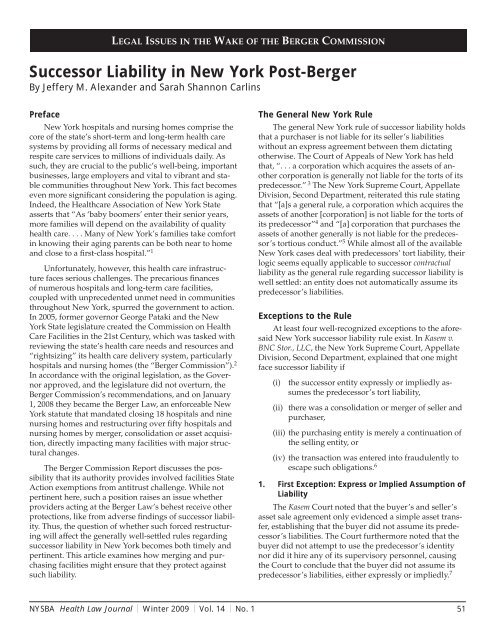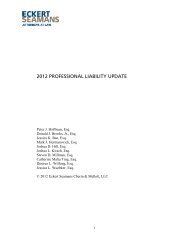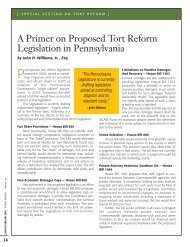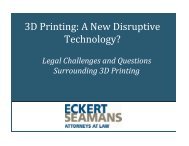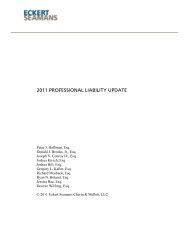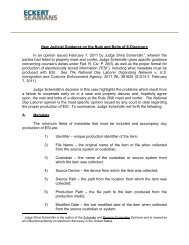Successor Liability in New York Post-Berger - Eckert Seamans
Successor Liability in New York Post-Berger - Eckert Seamans
Successor Liability in New York Post-Berger - Eckert Seamans
Create successful ePaper yourself
Turn your PDF publications into a flip-book with our unique Google optimized e-Paper software.
LEGAL ISSUES IN THE WAKE OF THE BERGER COMMISSION<br />
<strong>Successor</strong> <strong>Liability</strong> <strong>in</strong> <strong>New</strong> <strong>York</strong> <strong>Post</strong>-<strong>Berger</strong><br />
By Jeffery M. Alexander and Sarah Shannon Carl<strong>in</strong>s<br />
Preface<br />
<strong>New</strong> <strong>York</strong> hospitals and nurs<strong>in</strong>g homes comprise the<br />
core of the state’s short-term and long-term health care<br />
systems by provid<strong>in</strong>g all forms of necessary medical and<br />
respite care services to millions of <strong>in</strong>dividuals daily. As<br />
such, they are crucial to the public’s well-be<strong>in</strong>g, important<br />
bus<strong>in</strong>esses, large employers and vital to vibrant and stable<br />
communities throughout <strong>New</strong> <strong>York</strong>. This fact becomes<br />
even more signifi cant consider<strong>in</strong>g the population is ag<strong>in</strong>g.<br />
Indeed, the Healthcare Association of <strong>New</strong> <strong>York</strong> State<br />
asserts that “As ‘baby boomers’ enter their senior years,<br />
more families will depend on the availability of quality<br />
health care. . . . Many of <strong>New</strong> <strong>York</strong>’s families take comfort<br />
<strong>in</strong> know<strong>in</strong>g their ag<strong>in</strong>g parents can be both near to home<br />
and close to a fi rst-class hospital.” 1<br />
Unfortunately, however, this health care <strong>in</strong>frastructure<br />
faces serious challenges. The precarious fi nances<br />
of numerous hospitals and long-term care facilities,<br />
coupled with unprecedented unmet need <strong>in</strong> communities<br />
throughout <strong>New</strong> <strong>York</strong>, spurred the government to action.<br />
In 2005, former governor George Pataki and the <strong>New</strong><br />
<strong>York</strong> State legislature created the Commission on Health<br />
Care Facilities <strong>in</strong> the 21st Century, which was tasked with<br />
review<strong>in</strong>g the state’s health care needs and resources and<br />
“rightsiz<strong>in</strong>g” its health care delivery system, particularly<br />
hospitals and nurs<strong>in</strong>g homes (the “<strong>Berger</strong> Commission”). 2<br />
In accordance with the orig<strong>in</strong>al legislation, as the Governor<br />
approved, and the legislature did not overturn, the<br />
<strong>Berger</strong> Commission’s recommendations, and on January<br />
1, 2008 they became the <strong>Berger</strong> Law, an enforceable <strong>New</strong><br />
<strong>York</strong> statute that mandated clos<strong>in</strong>g 18 hospitals and n<strong>in</strong>e<br />
nurs<strong>in</strong>g homes and restructur<strong>in</strong>g over fi fty hospitals and<br />
nurs<strong>in</strong>g homes by merger, consolidation or asset acquisition,<br />
directly impact<strong>in</strong>g many facilities with major structural<br />
changes.<br />
The <strong>Berger</strong> Commission Report discusses the possibility<br />
that its authority provides <strong>in</strong>volved facilities State<br />
Action exemptions from antitrust challenge. While not<br />
pert<strong>in</strong>ent here, such a position raises an issue whether<br />
providers act<strong>in</strong>g at the <strong>Berger</strong> Law’s behest receive other<br />
protections, like from adverse fi nd<strong>in</strong>gs of successor liability.<br />
Thus, the question of whether such forced restructur<strong>in</strong>g<br />
will affect the generally well-settled rules regard<strong>in</strong>g<br />
successor liability <strong>in</strong> <strong>New</strong> <strong>York</strong> becomes both timely and<br />
pert<strong>in</strong>ent. This article exam<strong>in</strong>es how merg<strong>in</strong>g and purchas<strong>in</strong>g<br />
facilities might ensure that they protect aga<strong>in</strong>st<br />
such liability.<br />
The General <strong>New</strong> <strong>York</strong> Rule<br />
The general <strong>New</strong> <strong>York</strong> rule of successor liability holds<br />
that a purchaser is not liable for its seller’s liabilities<br />
without an express agreement between them dictat<strong>in</strong>g<br />
otherwise. The Court of Appeals of <strong>New</strong> <strong>York</strong> has held<br />
that, “. . . a corporation which acquires the assets of another<br />
corporation is generally not liable for the torts of its<br />
predecessor.” 3 The <strong>New</strong> <strong>York</strong> Supreme Court, Appellate<br />
Division, Second Department, reiterated this rule stat<strong>in</strong>g<br />
that “[a]s a general rule, a corporation which acquires the<br />
assets of another [corporation] is not liable for the torts of<br />
its predecessor” 4 and “[a] corporation that purchases the<br />
assets of another generally is not liable for the predecessor’s<br />
tortious conduct.” 5 While almost all of the available<br />
<strong>New</strong> <strong>York</strong> cases deal with predecessors’ tort liability, their<br />
logic seems equally applicable to successor contractual<br />
liability as the general rule regard<strong>in</strong>g successor liability is<br />
well settled: an entity does not automatically assume its<br />
predecessor’s liabilities.<br />
Exceptions to the Rule<br />
At least four well-recognized exceptions to the aforesaid<br />
<strong>New</strong> <strong>York</strong> successor liability rule exist. In Kasem v.<br />
BNC Stor., LLC, the <strong>New</strong> <strong>York</strong> Supreme Court, Appellate<br />
Division, Second Department, expla<strong>in</strong>ed that one might<br />
face successor liability if<br />
(i) the successor entity expressly or impliedly assumes<br />
the predecessor’s tort liability,<br />
(ii) there was a consolidation or merger of seller and<br />
purchaser,<br />
(iii) the purchas<strong>in</strong>g entity is merely a cont<strong>in</strong>uation of<br />
the sell<strong>in</strong>g entity, or<br />
(iv) the transaction was entered <strong>in</strong>to fraudulently to<br />
escape such obligations. 6<br />
1. First Exception: Express or Implied Assumption of<br />
<strong>Liability</strong><br />
The Kasem Court noted that the buyer’s and seller’s<br />
asset sale agreement only evidenced a simple asset transfer,<br />
establish<strong>in</strong>g that the buyer did not assume its predecessor’s<br />
liabilities. The Court furthermore noted that the<br />
buyer did not attempt to use the predecessor’s identity<br />
nor did it hire any of its supervisory personnel, caus<strong>in</strong>g<br />
the Court to conclude that the buyer did not assume its<br />
predecessor’s liabilities, either expressly or impliedly. 7<br />
NYSBA Health Law Journal | W<strong>in</strong>ter 2009 | Vol. 14 | No. 1 51
LEGAL ISSUES IN THE WAKE OF THE BERGER COMMISSION<br />
Similarly, <strong>in</strong> In re Seventh Jud. Dist. Asbestos Litig., the Supreme<br />
Court of Ontario County observed that “under the<br />
asset purchase agreement, the purchaser did not assume<br />
any of the liabilities of the seller.” 8 Therefore, the assetsale<br />
agreement itself provides the fi rst <strong>in</strong>dication whether<br />
liabilities are assumed where<strong>in</strong> if it fails to so specifi cally<br />
state, the court will be reluctant to make such an assumption.<br />
This also may be true if the asset-transfer agreement<br />
del<strong>in</strong>eates transfer of only specifi c seller liabilities to the<br />
purchaser, us<strong>in</strong>g a similar argument that the parties only<br />
agreed to the purchaser assum<strong>in</strong>g particular, but not all,<br />
seller liabilities.<br />
2. Second Exception: Consolidation or Merger<br />
The <strong>New</strong> <strong>York</strong> Supreme Court, Appellate Division,<br />
First Department, <strong>in</strong> Van Nocker v. A.W. Chesteron, Co. 9<br />
discussed the second successor liability exception. The<br />
court notes that asset purchases even can be constructed<br />
to constitute de facto mergers, thus caus<strong>in</strong>g successor liability<br />
to apply, if the asset purchase <strong>in</strong>cludes the follow<strong>in</strong>g<br />
four factors:<br />
(i) cont<strong>in</strong>uity of ownership,<br />
(ii) the seller ceas<strong>in</strong>g ord<strong>in</strong>ary bus<strong>in</strong>ess operations<br />
and dissolv<strong>in</strong>g as soon as possible after the<br />
transaction,<br />
(iii) the buyer assum<strong>in</strong>g liabilities ord<strong>in</strong>arily necessary<br />
to cont<strong>in</strong>ue the seller’s bus<strong>in</strong>ess un<strong>in</strong>terrupted,<br />
and<br />
(iv) the buyer cont<strong>in</strong>u<strong>in</strong>g the successor’s management,<br />
personnel, physical location, assets and<br />
general bus<strong>in</strong>ess operation. 10<br />
The court further expla<strong>in</strong>ed that while a fi nd<strong>in</strong>g of de<br />
facto merger does not necessarily require all of these factors,<br />
existence of each of the fi rst two is required. Accord<strong>in</strong>g<br />
to the Court, cont<strong>in</strong>uity of ownership exists “where<br />
the shareholders of the predecessor corporation become<br />
direct or <strong>in</strong>direct shareholders of the successor corporation.<br />
. . . Stated otherwise, cont<strong>in</strong>uity of ownership<br />
describes a situation where the parties to the transaction<br />
‘become owners together of what formerly belonged to<br />
each.’” 11 The Van Nocker Court, fail<strong>in</strong>g to fi nd either of<br />
the fi rst two de facto merger elements, thus decl<strong>in</strong>ed to<br />
analyze the rema<strong>in</strong><strong>in</strong>g factors.<br />
In an earlier case, the Fourth Department of the <strong>New</strong><br />
<strong>York</strong> Supreme Court, Appellate Division, took a more<br />
fl exible approach to determ<strong>in</strong><strong>in</strong>g whether a transaction<br />
constituted a de facto merger, reason<strong>in</strong>g that “[w]hile factors<br />
such as shareholder and management cont<strong>in</strong>uity will<br />
be evidence that a de facto merger has occurred, those<br />
factors alone shall not be determ<strong>in</strong>ative.” 12 More recently,<br />
the U.S. District Court for the Southern District of <strong>New</strong><br />
<strong>York</strong> exam<strong>in</strong>ed the cont<strong>in</strong>uity of ownership element of de<br />
facto merger under <strong>New</strong> <strong>York</strong> law and stated, “‘[T]he de<br />
facto merger doctr<strong>in</strong>e creates successor liability when the<br />
transaction between the purchas<strong>in</strong>g and sell<strong>in</strong>g companies<br />
is <strong>in</strong> substance, if not <strong>in</strong> form, a merger.’” 13 The Court<br />
then listed the above referenced four factors to determ<strong>in</strong>e<br />
whether a de facto merger exists, not<strong>in</strong>g that “the Court<br />
should consider the factors ‘<strong>in</strong> a fl exible manner that<br />
disregards mere questions of form and asks whether, <strong>in</strong><br />
substance, it was the <strong>in</strong>tent of the successor to absorb and<br />
cont<strong>in</strong>ue the operation of the predecessor.’” 14 This Court<br />
further noted, however, that cont<strong>in</strong>uity of ownership also<br />
is a prerequisite to fi nd<strong>in</strong>g a de facto merger. 15<br />
This Court also analyzed the de facto merger’s fourth<br />
factor, observ<strong>in</strong>g that “‘[t]he mere hir<strong>in</strong>g of some of the<br />
predecessor’s employees is <strong>in</strong>suffi cient to raise a triable<br />
issue as to cont<strong>in</strong>uity of management.’” 16 The Court did<br />
not fi nd a de facto merger, hold<strong>in</strong>g that <strong>in</strong> this case an attorney<br />
merely switched employers, br<strong>in</strong>g<strong>in</strong>g some of his<br />
established caseload to his new fi rm, along with a secretary<br />
and an associate, which did not constitute a merger<br />
or consolidation. Thus, when analyz<strong>in</strong>g the de facto<br />
merger exception, courts m<strong>in</strong>imally require cont<strong>in</strong>uity of<br />
ownership before consider<strong>in</strong>g the other three factors. And<br />
while the cases reference stock ownership as the exclusive<br />
evidence of ownership cont<strong>in</strong>uity, stock ownership, of<br />
course, is immaterial to not-for-profi t corporations that<br />
have no shareholders or stock. Therefore, how would<br />
ownership cont<strong>in</strong>uity be determ<strong>in</strong>ed <strong>in</strong> the not-for-profi t<br />
realm? For example, would a surviv<strong>in</strong>g <strong>in</strong>stitution that reta<strong>in</strong>s<br />
its Board, but accedes to a new corporate member/<br />
new corporate parent or that reta<strong>in</strong>s its Board and/or corporate<br />
member, but adds additional, new Board members<br />
and/or corporate members to itself and/or to its parent<br />
company, constitute ownership cont<strong>in</strong>uity?<br />
3. Third and Fourth Exceptions: Mere Cont<strong>in</strong>uation<br />
and Fraudulent Transaction<br />
Case law analyz<strong>in</strong>g what constitutes a company’s<br />
cont<strong>in</strong>uation or a fraudulent transaction is sparse. Rather<br />
than the mere cont<strong>in</strong>uation exception, <strong>New</strong> <strong>York</strong> has<br />
adopted the cont<strong>in</strong>uity of enterprise exception, which<br />
is very similar to the mere cont<strong>in</strong>uation exception and<br />
which is discussed further below. In the Seventh Jud. Dist.<br />
case, however, the pla<strong>in</strong>tiff asked the court to apply a<br />
mere cont<strong>in</strong>uation exception <strong>in</strong> a claim aga<strong>in</strong>st a successor.<br />
The Court reasoned that “mere cont<strong>in</strong>uation” essentially<br />
describes a corporate reorganization, where<strong>in</strong> one<br />
entity is dissolved and another survives the transaction. 17<br />
As the seller was not dissolved for more than a year<br />
after the asset sale, the Court held the mere cont<strong>in</strong>uation<br />
exception <strong>in</strong>applicable. In other jurisdictions, the mere<br />
cont<strong>in</strong>uation exception requires cont<strong>in</strong>uity of owners<br />
52 NYSBA Health Law Journal | W<strong>in</strong>ter 2009 | Vol. 14 | No. 1
LEGAL ISSUES IN THE WAKE OF THE BERGER COMMISSION<br />
and/or directors between the predecessor and the successor<br />
entities. 18<br />
Regard<strong>in</strong>g fraudulent transactions, <strong>New</strong> <strong>York</strong> courts<br />
may recognize a cause of action where an asset purchase<br />
“‘is entered <strong>in</strong>to fraudulently to escape [tort] obligations,’<br />
[but] no published <strong>New</strong> <strong>York</strong> decision appears to have<br />
analyzed the contours of the fraud exception.” 19<br />
4. Other Exceptions: Cont<strong>in</strong>uity of Enterprise and<br />
of Product L<strong>in</strong>e<br />
In addition to the generally recognized four successor<br />
liability exceptions, there are two lesser known ones: the<br />
“cont<strong>in</strong>uity of enterprise” theory and the “product l<strong>in</strong>e”<br />
exception, both of which are discussed <strong>in</strong> Salvati v. Blaw-<br />
Knox Food & Chemical Equipment, Inc. 20<br />
a. Cont<strong>in</strong>uity of Enterprise Theory<br />
In 1983, <strong>New</strong> <strong>York</strong>’s Court of Appeals recognized<br />
this exception, defi n<strong>in</strong>g it as “corporate reorganization,”<br />
but failed to discuss it <strong>in</strong> detail. 21 The Supreme Court<br />
of Queens County, later <strong>in</strong> Salvati, expla<strong>in</strong>ed that the<br />
cont<strong>in</strong>uity of enterprise theory, <strong>in</strong> which the successor<br />
entity claims to be cont<strong>in</strong>u<strong>in</strong>g the orig<strong>in</strong>al enterprise, was<br />
orig<strong>in</strong>ally set forth by the Supreme Court of Michigan <strong>in</strong><br />
Turner v. Bitum<strong>in</strong>ous Cas. Co. 22 Salvati noted the Michigan<br />
Court’s rationale, that it “would be unjust to allow the<br />
successor to hold itself out <strong>in</strong> this manner for the purpose<br />
of sales, while allow<strong>in</strong>g it to deny cont<strong>in</strong>uity <strong>in</strong> order to<br />
defeat products liability claims.” 23 Moreover, Salvati set<br />
forth the Michigan court’s three criteria test for the existence<br />
of such cont<strong>in</strong>uity:<br />
whether there was a cont<strong>in</strong>uation of the<br />
enterprise of the orig<strong>in</strong>al entity; whether<br />
the orig<strong>in</strong>al entity ceased its ord<strong>in</strong>ary<br />
bus<strong>in</strong>ess operations and dissolved<br />
promptly after the transaction, and<br />
whether the purchas<strong>in</strong>g entity assumed<br />
those liabilities and obligations of the<br />
seller normally required for an un<strong>in</strong>terrupted<br />
cont<strong>in</strong>uation of the sellers’<br />
operation. 24<br />
Salvati accepted the logic of Turner, say<strong>in</strong>g that<br />
[t]he Turner approach has the virtue that<br />
it bases its imposition of liability upon<br />
the successor corporation’s own acts, <strong>in</strong><br />
hold<strong>in</strong>g itself out to be an unbroken cont<strong>in</strong>uation<br />
of the orig<strong>in</strong>al enterprise. . . . In<br />
each case the buyer assumed suffi cient<br />
obligations to cont<strong>in</strong>ue the seller’s bus<strong>in</strong>ess<br />
without <strong>in</strong>terruption . . . “cont<strong>in</strong>uity<br />
was the purpose, cont<strong>in</strong>uity was the<br />
watch word, cont<strong>in</strong>uity was the fact.” 25<br />
b. Product L<strong>in</strong>e Exception<br />
The product l<strong>in</strong>e exception to successor liability<br />
comes from the Supreme Court of California <strong>in</strong> Ray v.<br />
Alad Corp., 26 and refl ects a scenario where the successor<br />
company cont<strong>in</strong>ues to make the same products (or,<br />
ostensibly, if a service <strong>in</strong>dustry like health care, provides<br />
the same services) as the predecessor and that it exploits<br />
the predecessor’s name, goodwill and customer lists, for<br />
example, <strong>in</strong> order to help sell the products. Salvati noted<br />
that Ray set forth three criteria for impos<strong>in</strong>g product liability<br />
on a successor:<br />
(1) the virtual destruction of the pla<strong>in</strong>tiff’s<br />
remedies aga<strong>in</strong>st the orig<strong>in</strong>al<br />
manufacturer caused by the successor’s<br />
acquisition of the bus<strong>in</strong>ess,<br />
(2) the successor’s ability to assume the<br />
orig<strong>in</strong>al manufacturer’s riskspread<strong>in</strong>g<br />
role, and<br />
(3) the fairness of requir<strong>in</strong>g the successor<br />
to assume a responsibility for defective<br />
products that was a burden necessarily<br />
attached to the orig<strong>in</strong>al manufacturer’s<br />
goodwill be<strong>in</strong>g enjoyed by the successor<br />
<strong>in</strong> the cont<strong>in</strong>ued operation of the<br />
bus<strong>in</strong>ess. 27<br />
The Salvati Court, however, was unimpressed with<br />
the reason<strong>in</strong>g of Ray and decl<strong>in</strong>ed to endorse the product<br />
l<strong>in</strong>e theory, expla<strong>in</strong><strong>in</strong>g that<br />
[t]his court would prefer not to base its<br />
decision on the broad and sweep<strong>in</strong>g<br />
pr<strong>in</strong>ciples of social policy which underlie<br />
the “product l<strong>in</strong>e” theory of Ray. . . . The<br />
analysis and criteria set forth <strong>in</strong> Ray look<br />
primarily to the availability of a remedy,<br />
and implicitly to the location of a “deep<br />
pocket” to furnish that remedy. 28<br />
For a time, <strong>New</strong> <strong>York</strong> courts rema<strong>in</strong>ed unsettled<br />
about whether to accept these two additional exceptions.<br />
In Schumacher, the Court of Appeals allowed for the possibility<br />
that either theory might apply depend<strong>in</strong>g upon a<br />
case’s particular facts. In 2006, however, the same Court<br />
rejected the product l<strong>in</strong>e exception, reason<strong>in</strong>g that it<br />
placed responsibility for a defective product on an entity<br />
that played no role <strong>in</strong> putt<strong>in</strong>g that product <strong>in</strong>to the stream<br />
of commerce. While the court acknowledged that the<br />
orig<strong>in</strong>al company’s sale could destroy a future pla<strong>in</strong>tiff’s<br />
product liability remedy, it also held that “‘this is not a<br />
justifi cation for su<strong>in</strong>g the successor, but rather . . . merely<br />
a statement of the problem.’” 29 Thus the Semenetz Court<br />
further limits successful arguments that successor liability<br />
NYSBA Health Law Journal | W<strong>in</strong>ter 2009 | Vol. 14 | No. 1 53
LEGAL ISSUES IN THE WAKE OF THE BERGER COMMISSION<br />
exists even if the parties to the transaction fail to specifi -<br />
cally address transfer of the sell<strong>in</strong>g entity’s liabilities.<br />
Analysis<br />
In accordance with <strong>New</strong> <strong>York</strong>’s general rule of successor<br />
liability, a hospital or nurs<strong>in</strong>g home that acquires<br />
another facility’s assets and none—or a detailed modicum—of<br />
its contractual liabilities should not be held to<br />
have assumed all of its predecessor’s liabilities. Exceptions<br />
to this rule, however, if applicable, could harm a<br />
surviv<strong>in</strong>g health care entity’s claim that it lacks responsibility<br />
for its predecessor’s liabilities. Each exception must<br />
be considered and each factual scenario exam<strong>in</strong>ed with<strong>in</strong><br />
their context.<br />
1. First Exception: Has the successor expressly or<br />
impliedly assumed the predecessor’s liabilities?<br />
The actual agreement transferr<strong>in</strong>g the predecessor’s<br />
assets is most <strong>in</strong>structive on and important to prov<strong>in</strong>g<br />
this po<strong>in</strong>t. As previously noted, <strong>New</strong> <strong>York</strong> courts hold<br />
that purchasers fail<strong>in</strong>g to expressly assume their predecessors’<br />
liabilities <strong>in</strong> the document govern<strong>in</strong>g the transaction<br />
will not be deemed to have assumed them. In fact,<br />
as noted, this may be similarly true when the purchaser<br />
only assumes specifi c liabilities, <strong>in</strong> which <strong>in</strong>stance only<br />
those specifi cally referenced liabilities will be assumed.<br />
Furthermore, the courts will look to other factors, such<br />
as use of the predecessor’s name, to decide whether an<br />
implied assumption of liability exists. Nonetheless, the<br />
courts’ decisions thus far seem to evidence a reluctance<br />
to fi nd either express or implied assumption of liability<br />
without the parties’ clear <strong>in</strong>tention otherwise. Therefore,<br />
“post-<strong>Berger</strong> Law” asset–acquisition arrangements<br />
by hospitals or nurs<strong>in</strong>g homes should state with strict<br />
specifi city what, if any, liabilities are transferred to the<br />
acquirer and what happens with any that are reta<strong>in</strong>ed by<br />
the seller.<br />
2. Second Exception: Did the entities de facto<br />
consolidate or merge?<br />
The courts look to four factors to determ<strong>in</strong>e whether<br />
a de facto merger or consolidation occurred. And recall<br />
that <strong>New</strong> <strong>York</strong> courts have suggested that, m<strong>in</strong>imally,<br />
existence of the fi rst two factors is required to prove existence<br />
of a de facto consolidation or merger.<br />
a. Cont<strong>in</strong>uity of ownership<br />
In accordance with Van Nocker and Sweatland, courts<br />
might fi nd de facto mergers upon cont<strong>in</strong>uity of ownership<br />
and/or of management. And what <strong>in</strong> the health care<br />
context constitutes ownership or management cont<strong>in</strong>uity?<br />
On the taxable side, the criteria for health care de<br />
facto mergers and consolidations should be no different<br />
than for similar taxable bus<strong>in</strong>esses: the same, or predom<strong>in</strong>ately<br />
the same, shareholders and management. On the<br />
tax exempt health care side, the answer may be less clear.<br />
An acquisition required by the <strong>Berger</strong> Law that effectuates<br />
the seller’s prior management and/or board members<br />
conduct<strong>in</strong>g/govern<strong>in</strong>g the result<strong>in</strong>g bus<strong>in</strong>ess just<br />
as they did prior to the transaction, risks vulnerability to<br />
claims of be<strong>in</strong>g a de facto merger or consolidation, merely<br />
a cont<strong>in</strong>uation of the seller’s former bus<strong>in</strong>ess. A surviv<strong>in</strong>g<br />
provider’s acquisition of another facility’s assets under<br />
a <strong>Berger</strong> Law mandate, without cont<strong>in</strong>u<strong>in</strong>g that other<br />
facility’s prior management, ownership and/or control,<br />
should emphasize the transaction’s lack of ownership<br />
cont<strong>in</strong>uity.<br />
b. Cessation of the sell<strong>in</strong>g organization’s ord<strong>in</strong>ary<br />
bus<strong>in</strong>ess operations and its dissolution<br />
immediately follow<strong>in</strong>g the transaction<br />
A health care entity that sells its assets to another<br />
provider under the <strong>Berger</strong> Law likely would cease operations,<br />
return its operat<strong>in</strong>g certifi cate to the Department of<br />
Health and dissolve—however, not necessarily immediately.<br />
In such a circumstance, the non-surviv<strong>in</strong>g provider<br />
most likely must cont<strong>in</strong>ue to operate on at least some<br />
level while w<strong>in</strong>d<strong>in</strong>g up its bus<strong>in</strong>ess affairs and liabilities<br />
and await<strong>in</strong>g its state and federal fund<strong>in</strong>g, even if no<br />
longer as a licensed health care company. Apparently the<br />
longer that the seller rema<strong>in</strong>s operational <strong>in</strong> some capacity,<br />
the more tenuous the seller’s creditors reliance on this<br />
exception becomes.<br />
c. Buyer’s assumption of liabilities ord<strong>in</strong>arily<br />
necessary to cont<strong>in</strong>ue the seller’s bus<strong>in</strong>ess<br />
As mentioned above, the asset-purchase agreement<br />
specifi cally may limit the purchaser’s assumption of any,<br />
even m<strong>in</strong>imal, amounts of the seller’s liabilities and, without<br />
specifi c language to the contrary, courts are loathe<br />
to fi nd liabilities assumed. While the courts have not<br />
specifi cally described what degree of assumed liabilities<br />
by the purchaser necessarily constitutes “cont<strong>in</strong>u<strong>in</strong>g” the<br />
seller’s bus<strong>in</strong>ess, and thus responsibility for its liabilities,<br />
it should require more materiality than simply us<strong>in</strong>g the<br />
seller’s assets <strong>in</strong> the context of the same <strong>in</strong>dustry. For<br />
example, would assum<strong>in</strong>g exist<strong>in</strong>g physician leases <strong>in</strong> an<br />
acquired medical offi ce build<strong>in</strong>g constitute cont<strong>in</strong>uity?<br />
Would conversion of a hospital <strong>in</strong>to a nurs<strong>in</strong>g home suffi<br />
ce? No defi nitive conclusion exists.<br />
d. Cont<strong>in</strong>uity of the seller’s management,<br />
personnel, physical location, assets and<br />
general bus<strong>in</strong>ess operation<br />
As mentioned above, the courts briefl y discuss this<br />
factor, not<strong>in</strong>g that simply hir<strong>in</strong>g some of the seller’s former<br />
employees will not constitute this type of cont<strong>in</strong>uity.<br />
54 NYSBA Health Law Journal | W<strong>in</strong>ter 2009 | Vol. 14 | No. 1
LEGAL ISSUES IN THE WAKE OF THE BERGER COMMISSION<br />
Thus, an acquir<strong>in</strong>g health care provider employ<strong>in</strong>g some<br />
of a seller’s personnel is not thereby dispositive whether<br />
the acquirer becomes the seller’s successor.<br />
Similarly, while a hospital or nurs<strong>in</strong>g home acquir<strong>in</strong>g<br />
another’s assets might ma<strong>in</strong>ta<strong>in</strong> the seller’s physical<br />
location and general bus<strong>in</strong>ess operations, a variety of<br />
factual scenarios still could defeat claims that successor<br />
liability transfers to the acquirer. For example, does the<br />
new owner use the assets as, or even <strong>in</strong> the same manner<br />
as, the seller? Are the same services provided the same<br />
way or <strong>in</strong> the same amount? Do the seller’s reta<strong>in</strong>ed<br />
managers and employees perform the same or similar<br />
tasks, the same way, <strong>in</strong> the same capacity or at the same<br />
locale? What, if anyth<strong>in</strong>g, is different and which of these<br />
differences constitutes a material change from the seller’s<br />
operation?<br />
3. Third and Fourth Exceptions: Is the asset<br />
purchase a mere cont<strong>in</strong>uation or a<br />
fraudulent transaction?<br />
Clearly transactions required by the <strong>Berger</strong> Law<br />
should not be deemed fraudulent. The mere cont<strong>in</strong>uation<br />
theory is discussed below <strong>in</strong> the context of the cont<strong>in</strong>uity<br />
of enterprise theory.<br />
4. Cont<strong>in</strong>uity of Enterprise: Does the purchaser<br />
purport to cont<strong>in</strong>ue the orig<strong>in</strong>al enterprise?<br />
This, too, will depend upon a situation’s particular<br />
facts. Nonetheless, to be prudent, an acquir<strong>in</strong>g health<br />
care organization should consider emphasiz<strong>in</strong>g that it is<br />
purchas<strong>in</strong>g another party’s assets <strong>in</strong> order both to comply<br />
with the <strong>Berger</strong> Commission’s mandates and, <strong>in</strong> the<br />
spirit thereof, to expand its services and to augment or<br />
to diversify those that it already provides. Courts clearly<br />
believe that companies alleg<strong>in</strong>g to be their seller’s successor<br />
<strong>in</strong> order to reta<strong>in</strong> the seller’s bus<strong>in</strong>ess goodwill cannot<br />
later claim otherwise to avoid result<strong>in</strong>g successor liability.<br />
As the Salvati Court expla<strong>in</strong>s, the purchaser should<br />
not represent itself as an “unbroken cont<strong>in</strong>uation of the<br />
orig<strong>in</strong>al enterprise.” 30 Purchasers should be able to avoid<br />
a similar cont<strong>in</strong>uity claim by conv<strong>in</strong>c<strong>in</strong>gly demonstrat<strong>in</strong>g<br />
that the acquisition, rather than cont<strong>in</strong>u<strong>in</strong>g the seller’s<br />
enterprise, creates a new “whole,” that is, unique, different<br />
from or merely greater than its orig<strong>in</strong>al parts: new<br />
services, new locations for, or methods of, service provision,<br />
different strengths, different bus<strong>in</strong>ess methods, new<br />
governance or control.<br />
5. Product L<strong>in</strong>e Exception: Does the successor<br />
enterprise cont<strong>in</strong>ue the same bus<strong>in</strong>ess as the<br />
seller, us<strong>in</strong>g its name, goodwill and customers?<br />
As the Court of Appeals recently rejected this exception,<br />
it will not be further discussed here<strong>in</strong>.<br />
Conclusion<br />
Asset acquisition under the established <strong>New</strong> <strong>York</strong><br />
successor liability rule generally should not cause acquirers<br />
to assume their transferees’ liabilities absent their<br />
affi rmative assent otherwise; however, a number of recognized<br />
exceptions to this rule could expose purchasers to<br />
potential liability. Much of such an analysis will depend<br />
upon the particular facts pert<strong>in</strong>ent to the <strong>in</strong>dividual<br />
transaction.<br />
Still, a hospital or nurs<strong>in</strong>g home that acquires another<br />
provider’s assets <strong>in</strong> compliance with the <strong>Berger</strong> Commission’s<br />
mandates should attempt to guard aga<strong>in</strong>st <strong>in</strong>vit<strong>in</strong>g<br />
such liability by fi rst tak<strong>in</strong>g certa<strong>in</strong> actions. For example,<br />
compile an asset-purchase agreement clearly stat<strong>in</strong>g that<br />
the acquir<strong>in</strong>g entity does not assume any of the seller’s<br />
liabilities or, if it does, clearly refl ect<strong>in</strong>g only those specifi c<br />
liabilities be<strong>in</strong>g acquired. Second, if possible, the acquirer<br />
should avoid ma<strong>in</strong>ta<strong>in</strong><strong>in</strong>g the seller’s managers, shareholders/members/managers,<br />
ownership, structure or<br />
control, the fi rst factor that courts consider when analyz<strong>in</strong>g<br />
whether a de facto merger exists. In fact, if possible, the<br />
survivor also should encourage the seller to ma<strong>in</strong>ta<strong>in</strong> its<br />
corporate form for some time after the transaction closes,<br />
as this is another key factor that courts exam<strong>in</strong>e to determ<strong>in</strong>e<br />
whether successor liability passes.<br />
Similarly, the surviv<strong>in</strong>g entity <strong>in</strong> a post-<strong>Berger</strong> asset<br />
acquisition should publicly emphasize its cont<strong>in</strong>ued<br />
existence as a separate, <strong>in</strong>dependent enterprise, rather<br />
than merely as a cont<strong>in</strong>uation of the seller’s bus<strong>in</strong>ess. In<br />
this manner, the survivor also dispels the notion that the<br />
transaction <strong>in</strong> any way constitutes a corporate reorganization,<br />
thus further distanc<strong>in</strong>g itself from the cont<strong>in</strong>uity<br />
of enterprise exception to <strong>New</strong> <strong>York</strong>’s general successor<br />
liability rule.<br />
Courts logically should review transactions undertaken<br />
<strong>in</strong> compliance with a legal mandate, like the <strong>Berger</strong><br />
Law, somewhat differently than they would a similar, but<br />
purely market-driven accord. In such legally driven transactions,<br />
the parties’ actions possibly are not, or at least<br />
not entirely, voluntary. Although noth<strong>in</strong>g was found to<br />
actually evidence that courts will treat such transactions<br />
this way, acquir<strong>in</strong>g a provider’s assets compliant with<br />
a state law refl ect<strong>in</strong>g public policy concerns essential to<br />
improv<strong>in</strong>g the state’s health care <strong>in</strong>frastructure, fi nances<br />
and, even more important, public health, do deserve<br />
special scrut<strong>in</strong>y. Indeed, <strong>in</strong> Sweatland, the Fourth Department,<br />
Appellate Division of the Supreme Court, discussed<br />
tak<strong>in</strong>g a variety of factors <strong>in</strong>to account case-by-case when<br />
analyz<strong>in</strong>g whether successor liability exists:<br />
It is apparent from the nature of the<br />
<strong>in</strong>quiry required that the court is to make,<br />
NYSBA Health Law Journal | W<strong>in</strong>ter 2009 | Vol. 14 | No. 1 55
LEGAL ISSUES IN THE WAKE OF THE BERGER COMMISSION<br />
on a case-by-case basis, an analysis of<br />
the weight and impact of a multitude<br />
of factors that relate to the corporate<br />
creation, succession, dissolution and<br />
successorship. 31<br />
Surely the goal of reform<strong>in</strong>g the state’s health care<br />
system to secure both its future viability and to ensure<br />
that millions of people throughout the state depend<strong>in</strong>g<br />
on it daily receive enhanced health care services is laudable<br />
and worthy of any support that the courts can offer.<br />
Endnotes<br />
1. “What’s at Stake 2008: The Impact of <strong>New</strong> <strong>York</strong>’s Hospitals on the<br />
Economy and Our Communities,” Healthcare Association of <strong>New</strong><br />
<strong>York</strong> State, January 2008, available at http://www.hanys.org.<br />
2. <strong>New</strong> <strong>York</strong> State Commission on Health Care Facilities <strong>in</strong> the 21st<br />
Century (http://www.nyhealthcarecommission.org).<br />
3. Schumacher v. Richards Shear Co., 59 N.Y.2d 239, 244 (1983).<br />
4. Rivera v. Anderson United Co., 283 A.D.2d 563, 564 (N.Y. App. Div.<br />
2d Dep’t 2001).<br />
5. Kasem v. BNC Stor., LLC, 30 A.D.3d 469, 470 (N.Y. App. Div. 2d<br />
Dep’t 2006), cit<strong>in</strong>g Schumacher v. Richards Shear Co., 59 N.Y.2d 239,<br />
244 and Rivera v. Anderson United Co., 283 A.D.2d 563, 564.<br />
6. Id. at 470.<br />
7. Id. at 470–471.<br />
8. In re Seventh Jud. Dist. Asbestos Litig., 788 N.Y.S.2d 579, 581 (Sup.<br />
Ct., Ontario Co. 2005).<br />
9. Van Nocker v. A.W. Chesteron, Co. (In re N.Y. City Asbestos Litig.), 15<br />
A.D.3d 254 (N.Y. App. Div. 1st Dep’t 2005).<br />
10. Id. at 256.<br />
11. Id., quot<strong>in</strong>g Cargo Partner AG v. Albatrans, Inc., 352 F3d 41, 47 (2d<br />
Cir. 2003).<br />
12. Sweatland v. Park Corp., 181 A.D.2d 243, 246 (N.Y. App. Div. 4th<br />
Dep’t 1992).<br />
13. Barrack, Rodos & Bac<strong>in</strong>e v. Ballon Stoll Bader & Nadler, P.C., 2008 U.S.<br />
Dist. LEXIS 22026, 17 (S.D.N.Y. 2008), quot<strong>in</strong>g <strong>New</strong> <strong>York</strong> v. Nat’l.<br />
Serv. Indus., Inc., 460 F.3d 201, 205 (2d Cir. 2006).<br />
14. Id. at 18, quot<strong>in</strong>g AT&S Transp., LLC v. Odyssey Logistics &<br />
Technology Corp., 803 N.Y.S.2d 118, 119 (2d Dep’t 2005).<br />
15. Id. at 19–20.<br />
16. Id. at 22, quot<strong>in</strong>g Kretzmer v. Firesafe Prods. Corp., 805 N.Y. S.2d 340,<br />
340 (1st Dep’t 2005).<br />
17. In re Seventh Jud. Dist. Asbestos Litig., 788 N.Y.S.2d 579, 581.<br />
18. See George W. Kuney, <strong>Successor</strong> <strong>Liability</strong> <strong>in</strong> <strong>New</strong> <strong>York</strong>, NYSBA<br />
Journal 24, pp. 22–27 (September 2007).<br />
19. Id., p. 23.<br />
20. Salvati v. Blaw-Knox Food & Chemical Equipment, Inc. 497 N.Y.S.2d<br />
242 (N.Y. Sup. Ct. 1985).<br />
21. Schumacher v. Richards Shear Company, Inc., 59 N.Y.2d 239, 245<br />
(1983).<br />
22. Salvati v. Blaw-Knox Food & Chemical Equipment, Inc. 497 N.Y.S.2d<br />
242, 244 cit<strong>in</strong>g Turner v. Bitum<strong>in</strong>ous Cas. Co., 244 N.W.2d 873 (Mich.<br />
1976).<br />
23. Id.<br />
24. Id.<br />
25. Id. at 247.<br />
26. Ray v. Alad Corp., 560 P.2d 3 (Cal. 1977).<br />
27. Salvati v. Blaw-Knox Food & Chemical Equipment, Inc., 497 N.Y.S.2d<br />
242, 244–245.<br />
28. Id. at 247.<br />
29. Sementez v. Sherl<strong>in</strong>g & Walden, Inc., 7 N.Y.3d 194, 200 (N.Y. 2006),<br />
quot<strong>in</strong>g Fish v. Amsted Indus., Inc., 126 Wis. 2d 293, 305–306 (1985).<br />
30. Salvati v. Blaw-Knox Food & Chemical Equipment, Inc., 497 N.Y.S.2d<br />
242, 247.<br />
31. Sweatland v. Park Corp., 181 A.D.2d 243 at 246, quot<strong>in</strong>g Santa Maria<br />
v. Owens-Ill<strong>in</strong>ois, Inc., 808 F2d 848, 861 (1st Cir. Mass. 1986).<br />
Jeffery Alexander is a partner <strong>in</strong> the fi rm <strong>Eckert</strong><br />
<strong>Seamans</strong> Cher<strong>in</strong> & Mellott, LLC <strong>in</strong> its White Pla<strong>in</strong>s,<br />
<strong>New</strong> <strong>York</strong>, and Boston, Massachusetts, offi ces. His practice<br />
consists largely of represent<strong>in</strong>g health care <strong>in</strong>stitutions<br />
and other types of providers. Mr. Alexander previously<br />
served as <strong>in</strong>-house counsel at Cabr<strong>in</strong>i Medical<br />
Center <strong>in</strong> <strong>New</strong> <strong>York</strong> City and Strong Memorial Hospital<br />
<strong>in</strong> Rochester, <strong>New</strong> <strong>York</strong>.<br />
Sarah Shannon Carl<strong>in</strong>s is a senior associate <strong>in</strong> the<br />
fi rm <strong>Eckert</strong> <strong>Seamans</strong> Cher<strong>in</strong> & Mellott, LLC <strong>in</strong> its Pittsburgh<br />
offi ce. Her practice <strong>in</strong>cludes all varieties of health<br />
law challenges, <strong>in</strong>clud<strong>in</strong>g government and commercial<br />
payor, regulatory, anti-kickback and Stark Act issues.<br />
Mrs. Carl<strong>in</strong>s also practices real estate law <strong>in</strong> the areas of<br />
commercial development and of tax exempt uses.<br />
56 NYSBA Health Law Journal | W<strong>in</strong>ter 2009 | Vol. 14 | No. 1


